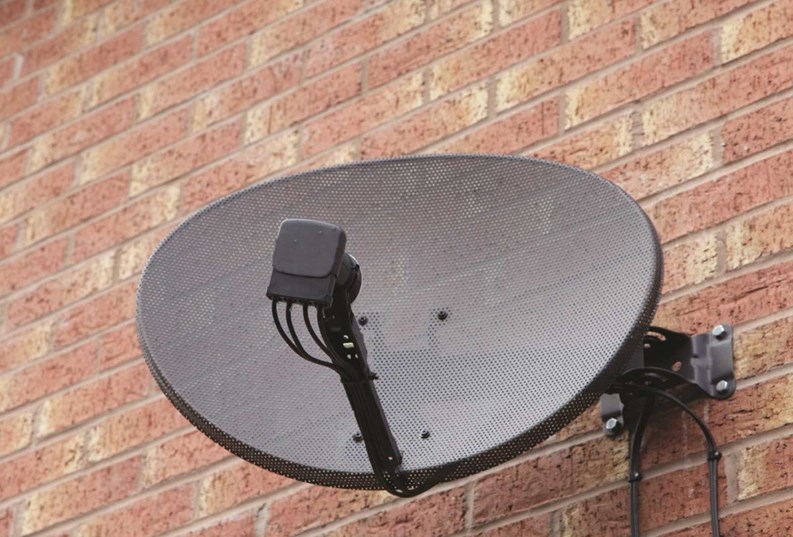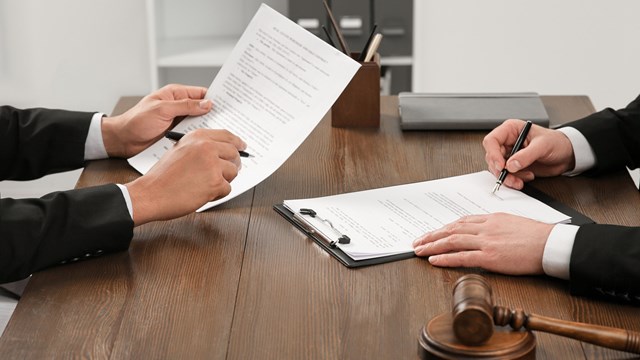With the advent of relatively cheap and accessible television source options such as Verizon’s FiOS TV, Cablevision’s Optimum and Comcast’s Xfinity, it might surprise some to hear that the seemingly antiquated satellite dish is still a mainstay in New England’s multifamily buildings. Trendy as they might be, dishes come with aesthetic and safety concerns from residents, boards and management companies alike.
Cell phone towers are the next tech accessory to become increasingly prevalent in multifamily buildings. Gone are the days when they simply signified increased coverage, communication abilities and the end of the dreaded dropped call. Tower sites can now serve as an additional source of income to buildings that lease out property space to cell companies. While the added income is highly beneficial to associations, cell sites can pose structural threats if not installed/maintained properly, or worse, leave associations trapped in an unfair lease.
Dish Debacles
The number of clunky dishes peppered atop East Boston homes grew at such an overwhelming rate within the past few years that local politicians deemed them a threat to the neighborhood’s integrity.
East Boston City Council Member Salvatore LaMattina led an effort to implement a satellite dish control ordinance in 2012. The ordinance, which was supported by former Mayor Thomas Menino, “would require the removal of all out-of-use satellite dishes. It would also ban new installations from facades and other walls that face the street, unless an installer can prove there is no other place or way to get a signal. Dishes would have to be placed on roofs, in the rear, or on the sides of buildings,” as reported by The Boston Globe.
Ultimately, the ordinance was blocked by the Federal Communications Commission (FCC) for being in violation of the entity’s rules for Over-the-Air-Reception-Devices (OTARD), which were adopted in 1996. According to the FCC, OTARD rules prohibit restrictions on a property owner or tenant’s right to install, maintain or use an antenna to receive video programming from direct broadcast satellites, broadband radio services and television broadcast stations. The rules apply specifically to dishes that are one meter or less in diameter and used to receive direct broadcast services.
OTARD allows local governments, community associations and landlords to enforce restrictions that do not impair the installation and maintenance of such equipment. Under some circumstances where a central or common antenna is available, a community association or landlord may restrict the installation of individual antennas. The rule does not apply to common areas that are owned by a landlord, community association or jointly by condominium or cooperative owners where the antenna user does not have an exclusive use area. Such common areas may include the roof or exterior wall of a multiple dwelling unit. Therefore, restrictions on antennas installed in or on such common areas are enforceable.
Patrick Brady, an attorney and partner with the Braintree, Massachusetts-based law firm of Marcus, Errico, Emmer & Brooks, P.C., breaks down the issue of owners’ dish rights in simple terms.
“Here’s the basic rule when it comes to a satellite dish in a condominium: First of all, the satellite rules apply to condominiums,” Brady says. “Basically, if you live in a multiple dwelling unit or a condominium, if the antennae user has an exclusive use area, meaning part of the property that only you can use, like an exclusive use deck or patio, then the resident has the absolute right to place a satellite dish within the exclusive use area. However, the antenna cannot hang over or protrude beyond the limited common area.”
Brady adds that lack of available reception in an owner’s exclusive use area does not mean an owner has the right to install the dish in a more reception-friendly spot outside his or her private space.
As evidence of the would-be ordinance in East Boston, the eyesore factor is a real problem when it comes to dishes. According to Jared McNabb, the director of acquisitions for Peabody, Massachusetts-based Crowninshield Management Corporation, associations are quick to regulate dishes in order to maintain curb appeal.
“Certainly, if you have a multi-unit building and every owner elects to install a satellite dish, it can really negatively impact the appearance of the building,” McNabb says. “Aside from that, the additional concern is how these things are attached to the building. If it’s wood siding or if it’s vinyl siding, you have the potential for it to impact the building envelope and add water infiltration and damage the exterior. When a board comes up with a satellite dish installation resolution policy, those are typically the two things they mandate, where they can be installed and how they can be installed,” he says.
A board can file a report with the FCC if an owner does not abide by association rules, Brady says.
Calling All Residents
The presence of cell phone towers has grown considerably in the past 25 years. There are currently more than 190,000 cell phone towers in the United States, according to Airwave Management, LLC, a full-service wireless consulting company with offices located in the New York City Metropolitan Area and North Carolina. Comparatively, there were only about 900 in 1985.
Buildings can hide cell towers on their rooftops. Typically, the cell company or wireless service provider negotiates a lease for an installation site and agrees to service and maintain the tower. The building benefits from rental income. Estimating potential monetary gain is not easy, as rent profits range vastly from location to location.
“Many people will tell you there is an average that is used but that is not the case—there is a very wide range when it comes to cell site rental rates,” says Steve Kazella, a partner at Airwave Management who has 14 years of wireless site acquisition experience. “Recently, we have seen a major carrier offer a cell site with no rent for the benefit of having coverage at their building and the surrounding neighborhood. We’ve seen a landlord take a deal for $100 per year ($8.33 per month) because they needed coverage so badly. And we’ve seen residential rooftops in the greater New York City metro area with carriers paying upwards of $6,000 and $7,000 per month because they had no other choice. There are some sites in Mass., New York and New Jersey only worth $1,200 or $1,300 per month, but there are others worth $2,500 to $4,000.”
According to Kazella, the price of a lease for a cell tower is not determined by a square foot basis, rather, value is determined by the coverage a particular site can provide. Other price factors include the price of other local competing sites, as well as the zoning and geographical characteristics of the site.
“Cell site pricing is all based on basic wireless economics of supply of available sites, and carrier’s demand for coverage,” Kazella explains.
The average cost of building a cell phone tower is around $150,000—but it’s often well worth the investment. The average yearly cell phone tower lease rate in the U.S. is $45,000. Massachusetts has the highest cell tower lease rates, ranging from $91,000–$535,000.
Rules and Regulations
According to the experts, there are several legal issues associated with contracting for the construction and use of a cell tower on a condominium building. Boards should consult with counsel because they might need membership approval before they can make any arrangements with the provider. If the condominium is part of a community of condominiums or subject to other deed restrictions, the board may have to garner the approval of neighboring residents as well. A board should look to its building’s documents for any allowance for leasing common area property, as well as owner approval requirements, if any.
Debunking Cell Tower Health Risk Rumors
Unfounded claims of cell tower radiation health hazards have buzzed about for the past two decades, leaving many worried towers are carcinogenic. The FCC investigated these rumors fully in 1996 and ultimately found that cell towers do not have an adverse effect on health, Kazella says. In fact, the FCC was so assured of cell tower site safety that it removed health concerns as a reason for turning down cell site applications from its policy, he adds.
The FCC might have declared cell towers safe 18 years ago, but that hasn’t prevented apprehension among some associations. McNabb, who managed a couple of associations that were approached to host a cell tower, says health concerns, among other apprehensions, proved to be a deterrent for signing the lease.
“There's always a faction in the community that is naturally concerned about health issues, specifically cancer or it being the cause of potentially dangerous radiation,” McNabb says.
Kazella acknowledges people’s health-based concerns, but says such trepidation toward cell towers needs to be addressed with factual information.
“When studies are done to present to planning or zoning boards, the actual emissions are significantly lower than those of standard everyday items that people utilize such as their computers, driving in their cars or even walking into sunlight,” Kazella says. “These frequencies are not new and have been used for years. Frequencies used in the late ’80s/early ’90s were from the old UHF televisions, and those were operating at much higher power levels. Usually cell phone towers operate at a fraction of what they are really allowed to. When studies are done, they show the worst case scenario with every channel in that cell site operating at full power, which is very rarely the case. Calculations show the cell site emissions are less than half of 1 percent of the allowable standards,” Kazella explains.
To Lease or not to Lease?
Sure, a regular separate, non-condominium-fee income might sound like a dream come true to an association, but a board has a lot to consider when deciding whether to host a cell tower. Factors such as a building’s structure, tower maintenance requirements and potential roof damage should be taken into account.
“It's not as easy as free money, because there are a lot of considerations, particularly community wise, that need to be taken into account,” McNabb says. “One of the concerns that several board members had was the impact on the roof. This was going to be on a rubber roof so there was concern about how it was attached to the building, the potential of it for catching wind up there, rocking back and forth and potentially damaging the rubber roof. Also, these are devices that need to be routinely serviced by the carrier or their contractors, so there was concern about accessing them as well—how frequently they needed to be accessed and if the folks accessing them would be mindful that the conditions they would be traversing up there would be relatively fragile, it being a rubber roof.”
Sign Carefully
Kazella says that while cell tower leases are a wonderful way for an association to get revenue, there is nothing worse than being stuck in a poorly crafted long term lease.
“We can’t stress enough that [associations should have] the same level of expertise [cell companies] possess when negotiating one of these deals,” he says. “If you do not have the same ability and expertise in analyzing this data and keeping everyone honest, you are negotiating from a position of weakness,” he warns. “Talk to an industry professional. Hiring the wrong consultant can literally be the difference of a few hundred thousand dollars over a 25 to 30 year period. It is also important that the consultants you hire have no conflicts working for any of the tower companies or carries. You need someone truly independent that will work in your best interests.”
Like any other association related business transaction/contract, it's the board's fiduciary duty to be well aware of the process and on the lookout for potential warning signs that could indicate shady practices.
“Red flags to look for are letters of intent, deal memos or term sheets which carrier representatives hurriedly rush you to sign,” Kazella says. “These need to be avoided, especially when you haven't seen the lease agreements or the architectural site plans. Never ever sign one of these documents before you have all the details. Also be careful of who you are dealing with when approached by smaller tower companies who are simply trying to lock up your property and flip the deal to a larger tower company. Make sure the carrier representative you are dealing with is working for a major carrier or tower company,” Kazella says. “Also,” he continues, “Look out for large lump sum payments up front from any consultant representing a carrier who offers you some sort of partnership deal to bring carriers to your location. Be cautious of any representative of a tower company or carrier who threatens to pull out of a deal because you hired a consultant to expedite the agreement. That is a major red flag when anyone views an industry expert as a threat, and not as a facilitator. It’s a telling sign that someone is trying to take advantage of the landlord,” he warns.
Enjolie Esteve is a freelance writer and contributor to New England Condominium. Freelance writer Danielle Braff also contributed to this article.







Leave a Comment